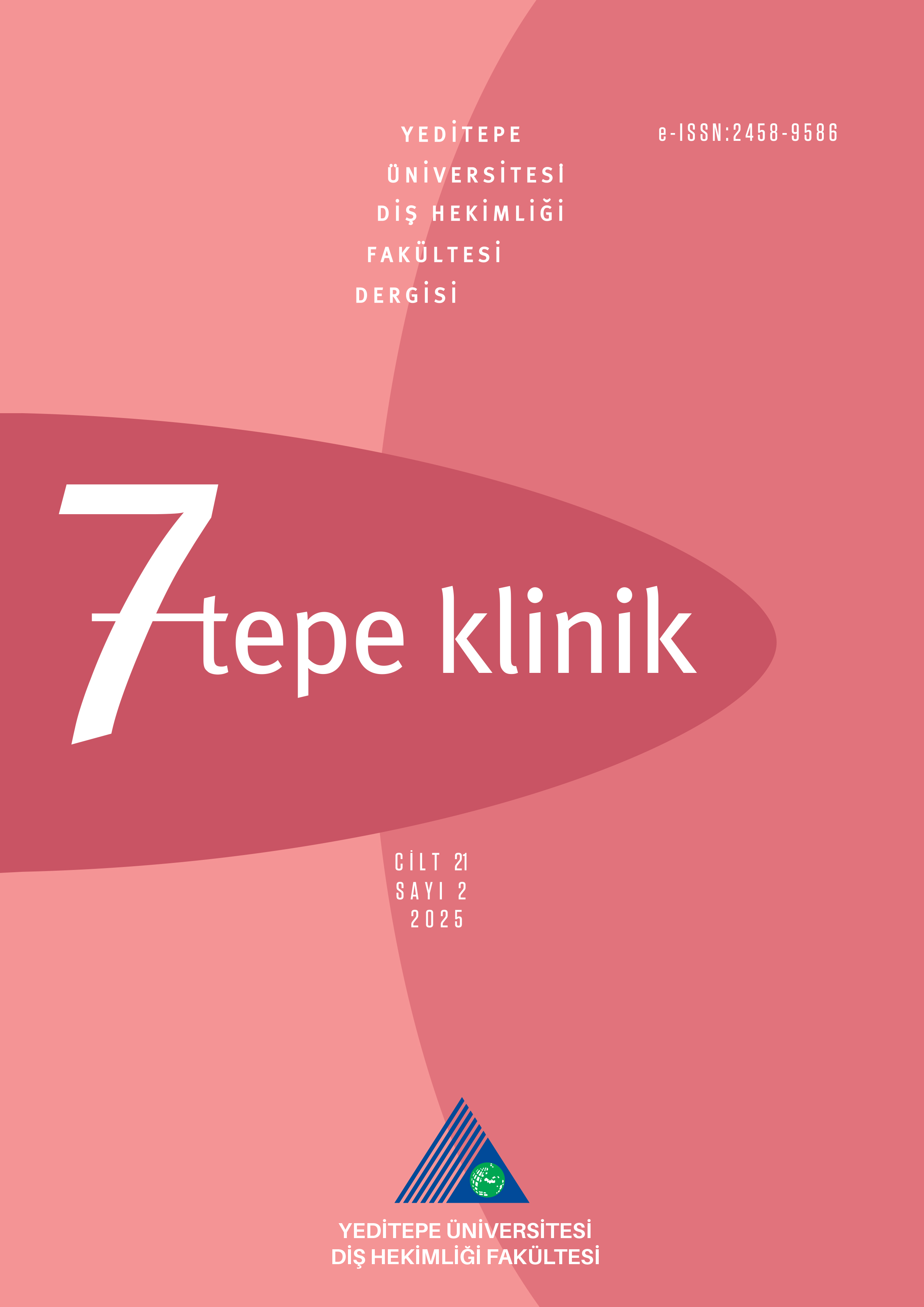Farklı yöntemlerle üretilen ve yüzey işlemleri uygulanan metal alt yapıların dental seramikler ile bağlantı dayanımlarının değerlendirilmesi: Deneysel çalışma
Faik Tugut, Ayşegül Göze Saygın, Didem DurukanSivas Cumhuriyet Üniversitesi Diş Hekimliği Fakültesi, Protetik Diş Tedavisi A.D., SivasGİRİŞ ve AMAÇ: Farklı yöntemlerle pürüzlendirilen krom-kobalt (Cr-Co) alt yapı malzemesi ile üst yapı porseleninin bağlanma dayanımının( PBD) değerlendirilmesi amaçlanmıştır.
YÖNTEM ve GEREÇLER: Disk şekilli Cr-Co alaşım üç farklı teknikle (Döküm, CAD/CAM, Lazer sinterleme) elde edildi. Örnekler, uygulanacak yüzey işlemine göre rastgele alt gruplara ayrıldı (n=10); GrupK: Al2O3 Kumlama (Kontrol grubu olarak), GrupE: Er-YAG lazer(1,5W), GrupN: Nd-YAG lazer (1,5W), GrupY: Ytterebirium lazer (10W). Örneklere yüzey şartlandırma sonrası veneer porseleni uygulandı. 24 saat süreyle 37˚C suda bekletilen örnekler, universal test cihazında kırıldı (0,5 mm/dk). Her bir gruptan alınan örneklerin yüzeylerinde olan değişiklikler taramalı elektron mikroskobunda (SEM) incelendi. İstatistiksel değelendirme için Kruskall-Wallis ve Mann-Whitney U testi kullanıldı.
BULGULAR: Farklı yüzey şartlandırma işlemleri ve üretim yöntemlerinin PBD değerleri arasındaki fark istatistiksel olarak anlamlı bulundu(p<0,05). Döküm ve CAD/CAM ile üretilen materyallerin farklı yüzey işlemleri sonrası PBD değerlerinin istatistiksel olarak anlamlı olmadığı fakat lazer işlemlerin kumlamaya benzer bağlanma dayanımı gösterdiği görüldü. En yüksek dayanım değerinin lazer sinter alt yapı üzerine uygulanan Nd-YAG lazer ile pürüzlendirme işleminde olup ve istatistiksel olarak anlamlı olduğu görüldü. Er-YAG ve Nd-YAG lazer uygulamalarının tüm alt yapı materyalleri arasında bağlanım dayanımı açısından istatistiksel olarak anlamlı olduğu (p<0,05) ve en yüksek CAD/CAM alt yapısında olduğu görüldü.
TARTIŞMA ve SONUÇ: PBD farklı üretim yöntemlerine ve yüzey şartlandırma işlemlerine göre değişebilir. Er-YAG ve Nd-YAG lazer uygulaması kumlamaya alternatif olarak gösterilebilir.
Evaluation of the bond strength with dental ceramics of metal substructures produced by different methods and applied with surface treatments: In-Vitro study
Faik Tugut, Ayşegül Göze Saygın, Didem DurukanSivas Cumhuriyet University Faculty of Dentistry, Department of Prosthodontics, Sivas, TurkeyINTRODUCTION: It was aimed to evaluate the shear bond strength (SBS) of chromium-cobalt (Cr-Co) infrastructure material and superstructure porcelain, which is roughened by different methods.
METHODS: Disc-shaped Cr-Co alloy was obtained by three different methods (Casting,CAD/CAM,Laser sintering). The samples were randomly divided intosubgroups according to the surface treatment to be applied (n=10); GroupK: Al2O3 Sandblasting (as Control group), GroupE: Er- YAG laser (1,5W), GroupN: Nd-YAG laser (1.5W), GroupY: Ytterebirium laser (10W). After surface treatments, veneer porcelain was applied to the samples. The samples, which were kept in water at 37˚C for 24 hours, were broken in a universal test machine (0,5 mm/min). The changes in the surfaces of the samples taken from each group were examined under scanning electron microscopy (SEM). Kruskall-Wallis and Mann-Whitney U tests were used for statistically analysis.
RESULTS: The difference between SBS values of different surface treatments and production methods was found to be statistically significant(p<0,05). It was observed that the SBS values of the materials produced by casting and CAD/CAM after different surface treatments were not statistically significant, but the bond strength of the laser treatments was similar to sandblasting. The highest strength value was found laser sinter infrastructure in the treated with the Nd-YAG laser and it was found to be statistically significant. It was seen that Er-YAG and Nd-YAG laser applications were statistically significant (p<0,05) among all infrastructure materials in terms of bond strength and the highest was in the CAD/CAM infrastructure.
DISCUSSION AND CONCLUSION: The SBS may vary according to different production methods and surface conditioning processes. Er-YAG and Nd-YAG laser application can be shown as an alternative to sandblasting.
Makale Dili: Türkçe



